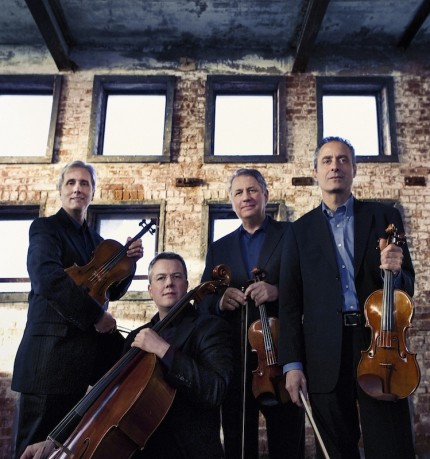Emerson Quartet’s marathon Haydn program shines fresh light at Ravinia

The Emerson String Quartet performed Haydn’s complete Op. 76 quartets Tuesday night at the Ravinia Festival. Photo: Lisa-Marie Mazzucco
In the universe of string ensembles, few American quartets have stood the test of time as well as the Emerson String Quartet. Founded in 1976, this group has achieved an enviable record boasting nine Grammys and three Gramophone awards among their claims to success (Paul Watkins smoothly succeeded founding cellist David Finckel in 2013).
Their annual return to Ravinia’s Martin Theater revealed a pointed yet gratifying display of musicianship Tuesday night, with Haydn’s complete Op. 76 quartets making up the entire program.
Even spanning nearly three hours with two intermissions, the Emerson Quartet navigated each work with a fresh and recharged originality, putting them comfortably at home with the father of the string quartet.
Unlike Haydn’s previous contributions to the genre, the six quartets of Opus 76 broke free from the confines of sonata-allegro form and segued into a more ambitious realm filled with rich harmonic sonorities. Written between 1796 and 1799, contemporaneous with his oratorio, The Creation, the quartets offer mellifluous moments sprinkled with quaint Viennese charm.
This was evident from the beginning, as violinists Eugene Drucker and Philip Setzer and violist Lawrence Dutton stood around an elevated platform where Watkins sat. This setup served the Emersons well, bringing the animated Watkins close to eye-level with his colleagues, allowed for quick communication and facial cues.
The first work of the opus, in the welcoming key of G-major, kicked off the evening. The three opening chords, executed with gusto, established the energetic character of the first movement. The passing of the coquettish melody among the players brought to light a wonderful contrast in character. During the hymn-like second movement, with subtle twinkling pianissimo interjections.
Nicknamed “Fifths,” from its falling initial figuration of perfect fifths, the second quartet mimics the hammer blows of Big Ben. While the first movement was technically deft in its delivery, the music remained more opaque and would have benefited from greater dynamic disparity. The third movement’s minuet here brings to mind not a stately courtly affair, but rather one of rhythmic rigidity and harrowing consequence. This sinister “Witches” minuet was illuminated by the Emersons with angular, propulsive playing, painting a vision of witches waltzing around their caldron.
The “Sunrise” quartet in B-flat major is the best known of the set, and here honeyed harmonies were abundant. Eugene Drucker, here playing first violin, provided a glowing stepwise motif in the Allegro con spirito and tender filigree throughout the Adagio. The Allegro finale took to the air like lightning during its electrifying coda.
There are few string quartets more recognized than Haydn’s “Emperor” which was posthumously named after the work’s second movement. (“God Save the Emperor Franz”) was Haydn’s stately homage to Francis II. Highlights here included Dutton’s rustic yet euphonious viola variation and Setzer’s shining upper register.
The last two works were the crown of the evening.The second movement of the “Fantasia” quartet, provided passages of polished, melting lyricism with the ardent corporate sensibility of the ensemble. The members, turning their attention towards each other through the labyrinth of harmonics. With apt rubato, coupled with dynamic swelling, the players granted the opportunity to relish the tender climax and the blissful aftermath.
The concluding work, the D-major quartet, highlighted the ensemble’s balance, allowing them, at times, to shine individually as well as together. Watkins’ dazzling passagework was showcased during the elegant minuet and the galloping presto fourth movement provided a rollicking close to a long but rewarding evening.
The Emerson Quartet will repeat the Haydn program July 12 at the Tanglewood Festival. tanglewood.org
Tyler Krause studied chemistry and music at Indiana University.